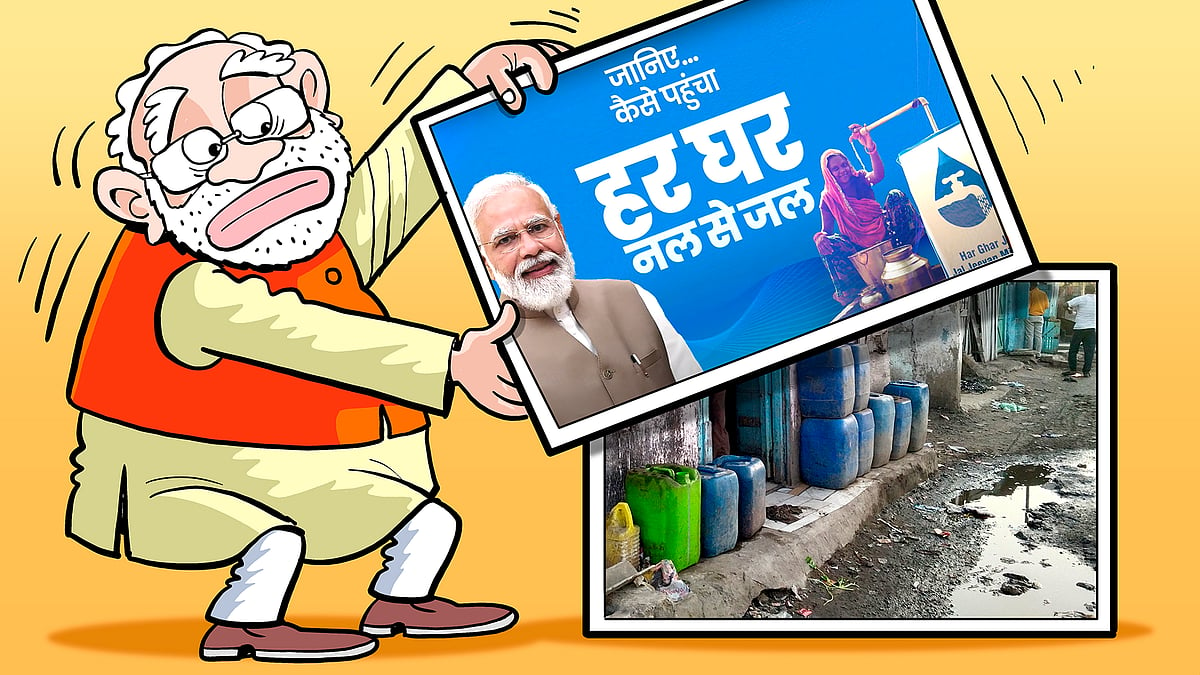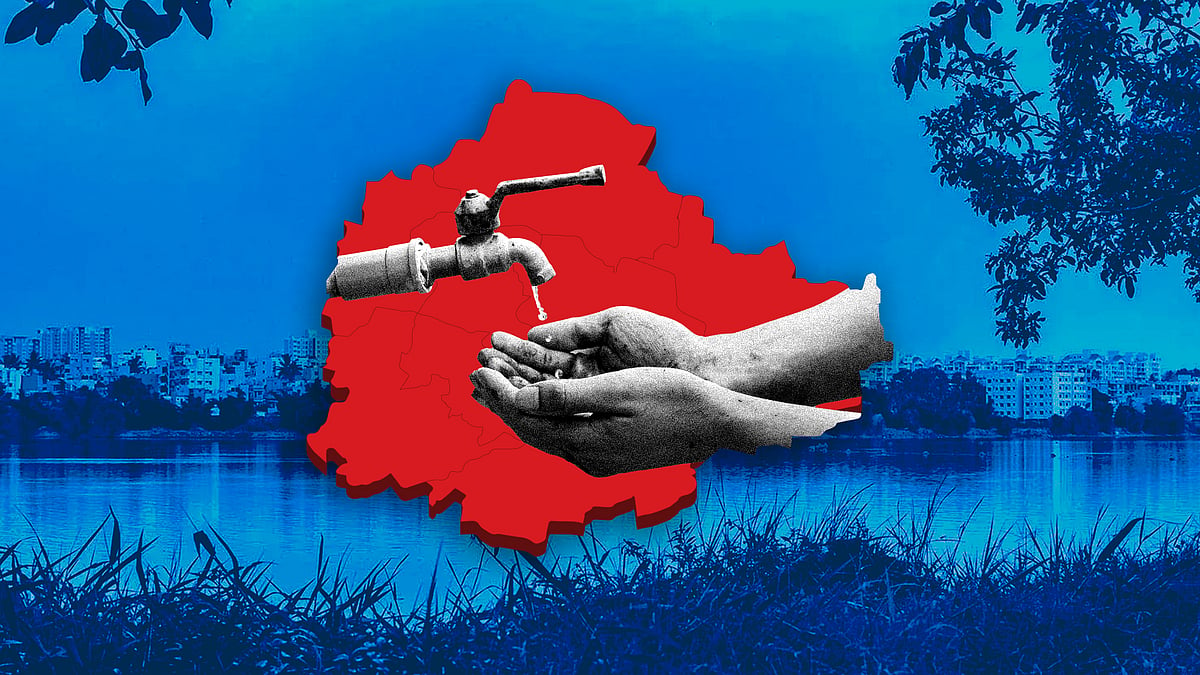Significant coverage but quality issues: Did Modi succeed in providing safe water to rural India?
An analysis of the hits and misses of the ambitious Jal Jeevan Mission scheme.
Several states – like Andhra Pradesh (73.41 percent), Karnataka (76.26), Meghalaya (76.86), Tamil Nadu (82.28), Assam (77.87 percent), Chhattisgarh (78.12), Manipur (78.55), Tripura (79.68), Odisha (73.14) and Uttar Pradesh (82.37) – have performed close to or slightly above the national average of 76 percent. Others like Arunachal Pradesh, Goa, Gujarat, Haryana, Himachal Pradesh, Mizoram, Punjab and Telangana are at 100 percent coverage. Bihar, typically chided as a poorly governed state, has managed an impressive coverage of 96.42 percent.
West Bengal, Rajasthan, Kerala and Jharkhand have the lowest coverage of 47.57, 48.47, 52.58 and 52.79 percent, respectively. They’ve reached just about half of their targeted households. Madhya Pradesh fares a tad better at 62 percent.
The case of Kerala is curious. Typically, the state is known for its stellar governance, particularly at the grassroots level. Why then does it languish at a coverage of 52.58 percent for a decentralised, demand-driven scheme? The anomaly is explained by a common culprit that has stymied India’s growth in umpteen ways – land acquisition. Difficulty in acquiring expensive land for various works under the scheme, coupled with the state government’s frayed finances, has delayed Kerala’s progress under JJM.
There are also interesting insights in the data on the 100 most backward blocks covered by JJM. For one, they’re spread across nine states and 37 districts, though 35 of them are in one state alone – West Bengal. Twenty-four are in Rajasthan, 14 in Jharkhand, and 12 in Uttar Pradesh. That nearly three-quarters of these blocks are from West Bengal, Rajasthan and Jharkhand is not surprising given the states’ overall poor performance, as discussed above.
Village committees
A pertinent reason for the failure of previous water provision schemes is ineffective grassroots engagement. It’s why JJM delegates much of the planning and execution to the local community by creating pani samitis, or village water and sanitation committees, that oversee all aspects of its implementation at the village level.
Each pani samiti is responsible for creating a village action plan to survey water needs and locally available resources to address them. Based on this, the state-level agency decides additional resources to be mobilised.
Data from government dashboard reveals that 90.12 percent of villages in India have a pani samiti. Nearly all of them have created a corresponding action plan for their village. Overall, most states have fared well on this metric with compliance of over 95 percent – except for Bihar, Telangana, Madhya Pradesh and Assam.
While the sub-par performance of Madhya Pradesh and Assam matches their overall coverage, the performances of Bihar and Telangana don’t add up.
Bihar has an overall coverage of 96.42 percent, as we discussed earlier, but only 6.28 percent of its villages have ever had a pani samiti. Correspondingly, the state recorded less than two percent village action plans. How then did Bihar attain near-universal coverage of functional tap connections? As per the state government, it was due to their Har Ghar Nal Ka Jal scheme launched in 2016, not JJM.
Similarly, Telangana attained 100 percent coverage with only 70 percent pani samitis and zero village action plans. According to its state government, this was a result of the Mission Bhagiratha scheme that provided functional tap connections to all rural households.
Water sources
“Slippage” is a major concern for most public interventions in water, sanitation and hygiene services. Slippage refers to a reduction in these services over time – habitations that previously had access to safe drinking water reporting a drop in services either in quantity or quality of water available.
According to India Water Portal, instances of slippage have marred past government initiatives to provide safe drinking water due to “excessive reliance on groundwater” for various projects, and the “unregulated extraction of groundwater for irrigation”. The report also flagged slippage due to unpredictable rainfall patterns, unregulated extraction of groundwater for irrigation, natural disasters, and irregular or unavailable power supply.
Under JJM, there is still an overwhelming pan-India reliance on groundwater for providing piped water to households.
73.89 percent of piped water connections provided so far use groundwater, raising major concerns about the scheme’s long-term viability. Households that are solely reliant on groundwater may suffer slippage, as has been seen in previous schemes.
After groundwater, the second most popular water source is surface water, referring to sources such as rivers, streams and lakes. Nationally, it provides coverage for 21.39 percent of functional household tap connections, though there is variance at the state-level. States with plentiful rivers and lakes – like the Himalayan and Northeastern states, Punjab, Kerala and others – rely overwhelmingly on surface water to reach households under JJM. This is a more sustainable source of water and these states are less likely to suffer from slippage, unless surface water pollution continues unabated.
The long-term challenge of slippage requires a renewed focus on rainwater harvesting structures and traditional sources of water which currently form less than one percent of the water source mix deployed. At a regional level, rejuvenation of old lakes, streams and ponds and providing and coordinating safe surface water sources could help alleviate the issue.
Any of these strategies must battle sociopolitical realities, like water theft and damage to regional water pipelines, which can even result from local political and social rivalries. For instance, in 2016, Jat protesters extensively damaged the Munak Canal, Delhi's water lifeline, to pressure the government for reservation quota.
Water quality
The other important factor affecting the long-term success of JJM is the quality of water supplied to households.
Water can suffer from both biological and chemical pollution that makes it unfit for human use. In fact, JJM guidelines lend equal importance to both the quality and quantity of water supplied. It deploys considerable resources to develop and maintain water quality testing labs at the state, district, block and village levels. There are also mobile vans and field survey kits, all of which are deployed to test the quality of piped water supplied to households at regular intervals for a range of contaminants.
The scheme also lays added emphasis on the use of IoT sensors to continuously monitor quality – however, these are still in pilot mode and haven’t been deployed universally.
That said, West Bengal had the highest chemically contaminated water samples in 2023-24 at 30.45 percent, followed by Rajasthan (20.07 percent), Karnataka (11.33 percent), Maharashtra (9.73 percent) and Gujarat (6.52 percent).
West Bengal also led the pack with the highest number of biologically contaminated samples that year at 47.15 percent, followed by Maharashtra (31.47), Uttar Pradesh (5.68), Kerala (5.22) and Haryana (4.09).
This data shows that providing piped water to households is only half the work done. The long-term success of the scheme hinges on upkeep of quality of water supplied which requires optimal testing, functional water treatment plants, and timely remedial intervention when cases of contamination are found.
However, data from the JJM dashboard (see here and here) shows that remedial measures were taken in only about 78 percent of cases of contamination. Similarly, only 70.64 percent of labs used for water quality testing under the scheme in India have received certification from the National Accreditation Board for Testing and Calibration Laboratories.
Independent assessments
In a report in 2023, the Parliamentary Standing Committee on Water Resources said social audits of JJM still haven’t been published on its website. The committee also said it was unable to access details on the 147 agencies that were onboarded for third-party inspections.
In the absence of these audits and inspections, the only other credible way to assess the impact of JJM is through a departmental evaluation carried out in 2022 by the Ministry of Jal Shakti.
The ministry used a sample survey to examine JJM under four parameters – (a) whether the tap provided was functional, (b) whether the quantity of water received was adequate, (c) whether the water supply was regular, and (d) whether the water was potable.
While 86 percent of households surveyed had a functional connection, only 62 percent satisfied all four criteria. Given that JJM has only covered 76.2 percent of eligible households so far, that means around 47 percent of the total have fully functional water connections.
When it comes to states and UTs, nine – Rajasthan, Andaman and Nicobar Islands, Kerala, Manipur, Tripura, Maharashtra, Madhya Pradesh, Mizoram and Sikkim – languish with overall functionality in the range of 38 to 48 percent.
The 2022 report has other worrying details. For instance, it says 57 percent of households across the country purify the water supplied via JJM before drinking. Why should they have to purify the water themselves? At least theoretically, JJM taps should provide potable water.
The report also found that only 30 percent of villages surveyed had a field test kit. Only 29 percent of pani samitis carried out a bacteriological test in the last one year. And only 21 percent had any mechanism to chlorinate contaminated water.
For brevity, here are other key findings:
• 38 percent of villages surveyed are aware of the existence of a pani samiti.
• Only 14 percent of villages have a pani samiti that’s responsible for operating and maintaining piped water supply schemes.
• 31 percent of villages have a person trained to use a field test kit.
• 31 percent have skilled manpower to operate and maintain piped water supply schemes.
• 19 percent of villages carry out community monitoring of water wastage.
Note that these on-the ground figures are sharply lower than the 90 percent figure provided by dashboard data. This discrepancy signals something important – that even as India rushes towards the theoretical completion of JJM, it should continuously assess, monitor and evaluate the ‘true’ completion of the scheme on the ground before declaring a victory on thirst in rural India.
If you’re reading this story, you’re not seeing a single advertisement. That’s because Newslaundry powers ad-free journalism that’s truly in public interest. Support our work and subscribe today.
 Kutch: Struggle for water in ‘har ghar jal’ Gujarat, salt workers fight for livelihoods
Kutch: Struggle for water in ‘har ghar jal’ Gujarat, salt workers fight for livelihoods  Over-exploited groundwater, neglected lakes: Here’s why Bengaluru is facing a water crisis
Over-exploited groundwater, neglected lakes: Here’s why Bengaluru is facing a water crisis 